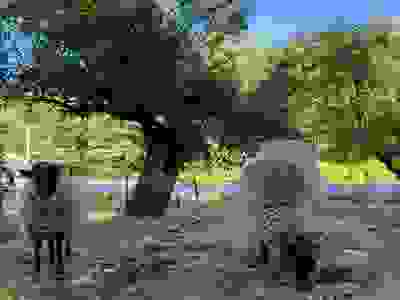
Come on In!
Welcome to Mid-Coast Maine
You’ve just found the wonderful woolly world of Mulberry Marsh Designs, a fiber farm producing eco-friendly healthful knit wearables.
Our Farm
Delve into the Process
Mulberry Marsh is home to our varied farm friends, some just for fiber, some for fun. All our animals work hard to produce for us and we give them the healthiest and longest lives possible. We currently keep seven sheep, two Shetland sheep - Pepper and Nutmeg, four Finnsheep - Sherlock, Sheba, Bart and Zeke; and Gabriel, a Border-Leicester Romney cross. These sheep are all naturally colored fiber animals, in shades of gray, whites and browns. They each bring a different natural color and texture to their wool.
Our Sheep are kept using maximally eco-friendly farming techniques. These include a rotational grazing system, fresh well water at all times, and mineral and grain supplements as needed – such as in sub-zero temperatures for sure! We only worm them on an as-needed basis after testing for parasites. Our 1850's era farmhouse, and attached barn, provides for easier winter feeding and cozy quarters when that polar vortex reaches its icy fingers southward. All our sheep are named and kept for fiber only, being allowed to live out their natural lives in the lush comfort of some of Maine's best pastureland. We do welcome farm visitors by appointment or chance.
Let me tell you a little about getting the wool from the sheep wearing it to us wearing it.
SHEARING
The sheep are happy to sit on their bottoms and give up their wooly fleeces which have become heavy and hot in the warming spring air. They also get a quick mani-pedi so their hooves don't get too long. Once removed, the fleeces will need to be “skirted”, any matted or very dirty bits thrown right out.
After a good soak in hot soapy water, rinsed in cool water – and using a mild non-toxic soap (this water makes for great plant fertilizer); and given a thorough dry, the fleece is ready for carding.
CARDING
Carding is the process of aligning the fibers in preparation for spinning. Hand carding is essentially using two little boards impregnated with many rows of little wire teeth to draw out the fibers, and then roll them into rolags which can be spun. There are also drum carders, combs, pickers and a variety of types of tools with longer and shorter nail-like teeth with which to align the fibers. Depending on the preparation of the wool fiber the ready-to-spin fluff, also called roving, can then be easily spun into yarn. It is in this carding process that one combines the different types of fibers for a blended yarn, wool and mohair, or alpaca, angora, camel, the list is seemingly endless.
SPINNING A YARN
The process of spinning is a bit like patting your tummy and rubbing your head, but once you get the hang of it is a relaxing and meditative activity. There are many different kinds of spinning wheels, made all over the world, including individually handcrafted wheels, antique wheels that can be refurbished for current use, and production wheels by such companies as Ashford in New Zealand.
The spinning of the rolags, or roving, into yarn, is typically spun in one direction on the wheel for one ply. Then one takes two bobbins of the one-ply yarn and twists them together in the opposite direction onto a third bobbin in order to make a two-ply yarn.
FINALLY THE KNITTING
The knitting is the wonderful culmination of all that work into a lovely warm and functional creation to be worn and touched and even cuddle into while watching a movie on a cold winter evening.
